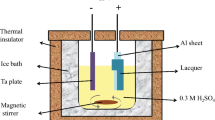Abstract
This study investigates the optimization of nickel-infused alumina nanostructure for enhanced solar-thermal energy conversion. The optimization is based on the analytical model using the transfer matrix method, which is first validated with experimental results and then compared with a finite element model. The optimal nanostructure of the solar absorber shows a high solar absorptance of 0.87 and a low thermal emittance of 0.08. The optimal design can achieve a total net heat flux of 815 W/m2, approximately 26% higher than the nominal value of 647 W/m2 corresponding to the baseline design.
Graphical abstract




Similar content being viewed by others
Data availability
Data will be made available on reasonable request.
References
L. Zhang et al., Highly efficient and salt rejecting solar evaporation via a wick-free confined water layer. Nat. Commun. (2022). https://doi.org/10.1038/s41467-022-28457-8
M. Li et al., Three-dimensional hollow reduced graphene oxide tube assembly for highly thermally conductive phase change composites and efficient solar-thermal energy conversion. ACS Appl. Mater. Interfaces (2023). https://doi.org/10.1021/acsami.3c00546
X. Wang, S. Narayan, Thermal radiative switching interface for energy-efficient temperature control. Renew. Energy (2022). https://doi.org/10.1016/j.renene.2022.07.143
X. Wang, S. Narayan, Thermochromic materials for smart windows: A state-of-art review. Front. Energy Res. (2021). https://doi.org/10.3389/fenrg.2021.800382
X. Wang, C.Y. Tso, B. Traipattanakul, C.Y.H. Chao, Development of a phase change material (pcm)-based thermal switch. HKIE Trans. Hong Kong Inst. Eng. (2017). https://doi.org/10.1080/1023697X.2017.1312560
F. Cao, K. McEnaney, G. Chen, Z. Ren, A review of cermet-based spectrally selective solar absorbers. Energy Environ Sci (2014). https://doi.org/10.1039/c3ee43825b
Y. Li, D. Li, D. Zhou, C. Chi, S. Yang, B. Huang, Efficient, scalable, and high-temperature selective solar absorbers based on hybrid-strategy plasmonic metamaterials. Sol. RRL (2018). https://doi.org/10.1002/solr.201800057
Y. Li, C. Lin, K. Li, C. Chi, B. Huang, Nanoparticle-on-mirror metamaterials for full-spectrum selective solar energy harvesting. Nano Lett. (2022). https://doi.org/10.1021/acs.nanolett.2c00322
V. Rinnerbauer et al., Recent developments in high-temperature photonic crystals for energy conversion. Energy Environ. Sci. (2012). https://doi.org/10.1039/c2ee22731b
H. Wang, H. Alshehri, H. Su, L. Wang, Design, fabrication and optical characterizations of large-area lithography-free ultrathin multilayer selective solar coatings with excellent thermal stability in air. Sol. Energy Mater. Sol. Cells (2017). https://doi.org/10.1016/j.solmat.2017.09.025
S. Zhao, E. Wackelgard, Optimization of solar absorbing three-layer coatings. Sol. Energy Mater. Sol. Cells (2006). https://doi.org/10.1016/j.solmat.2005.03.009
Z.Y. Nuru, D.E. Motaung, K. Kaviyarasu, M. Maaza, Optimization and preparation of pt-al2o3 double cermet as selective solar absorber coatings. J. Alloys Compd. (2016). https://doi.org/10.1016/j.jallcom.2015.12.201
S.Y. Lin et al., An in-situ and direct confirmation of super-planckian thermal radiation emitted from a metallic photonic-crystal at optical wavelengths. Sci. Rep. (2020). https://doi.org/10.1038/s41598-020-62063-2
X. Wang, H. Yang, M. Hsieh, J.A. Bur, S.-Y. Lin, S. Narayanan, Nickel-infused nanoporous alumina as tunable solar absorber. MRS Adv. (2020). https://doi.org/10.1557/adv.2020.300
X. Wang, M.-L. Hsieh, J.A. Bur, S.-Y. Lin, S. Narayanan, Capillary-driven solar-thermal water desalination using a porous selective absorber. Mater. Today Energy (2020). https://doi.org/10.1016/j.mtener.2020.100453
X. Wang, M.-L. Hsieh, J.A. Bur, S.-Y. Lin, S. Narayanan, The role of nanostructure morphology of nickel-infused alumina on solar-thermal energy conversion. J. Opt. 23(1) (2021). Art. no. 015101. https://doi.org/10.1088/2040-8986/abcc53.
S.-K. Hwang, S.-H. Jeong, H.-Y. Hwang, O.-J. Lee, K.-H. Lee, Fabrication of highly ordered pore array in anodic aluminum oxide. Korean J. Chem. Eng. (2002). https://doi.org/10.1007/BF02697158
C.T. Sousa, A. Apolinario, D.C. Leitao, A.M. Pereira, J. Ventura, J.P. Araujo, Precise control of the filling stages in branched nanopores. J. Mater. Chem. (2012). https://doi.org/10.1039/c2jm14828e
W. Lee, S.-J. Park, Porous anodic aluminum oxide: Anodization and templated synthesis of functional nanostructures. Chem. Rev. (2014). https://doi.org/10.1021/cr500002z
G.A. Niklasson, C.G. Granqvist, Optical properties and solar selectivity of coevaporated co-al 2o3 composite films. J. Appl. Phys. (1984). https://doi.org/10.1063/1.333386
V.A. Markel, Introduction to the maxwell garnett approximation: Tutorial. J. Opt. Soc. Am. A (2016). https://doi.org/10.1364/JOSAA.33.001244
L.A.A. Pettersson, L.S. Roman, O. Inganäs, Modeling photocurrent action spectra of photovoltaic devices based on organic thin films. J. Appl. Phys. (1999). https://doi.org/10.1063/1.370757
P. Peumans, A. Yakimov, S.R. Forrest, Small molecular weight organic thin-film photodetectors and solar cells. J. Appl. Phys. (2003). https://doi.org/10.1063/1.1534621
MATLAB. The MathWorks, Inc. [Online]. https://www.mathworks.com/products/matlab.html
J. Nocedal, S.J. Wright, Numerical Optimization. Springer US, 2006. [Online]. https://doi.org/10.1007/978-0-387-40065-5
H. Masuda, M. Satoh, Fabrication of gold nanodot array using anodic porous alumina as an evaporation mask. Jpn. J. Appl. Phys. Part 2 Lett. (1996). https://doi.org/10.1143/JJAP.35.L126
W. Lee, R. Ji, U. Gösele, K. Nielsch, Fast fabrication of long-range ordered porous alumina membranes by hard anodization. Nat. Mater. (2006). https://doi.org/10.1038/nmat1717
J. Salmi, J.P. Bonino, R.S. Bes, Nickel pigmented anodized aluminum as solar selective absorbers. J. Mater. Sci. (2000). https://doi.org/10.1023/A:1004773821962
G. Yan, S. Kaur, J.W. Banks, J.E. Hicken, Entropy-stable discontinuous galerkin difference methods for hyperbolic conservation laws. J. Comput. Appl. Math. (2023). https://doi.org/10.1016/j.cam.2022.114885
L.V.R. Cagliari, T. Babcock, J.E. Hicken, S. Mishra, Active flow control optimization with stability guarantees. AIAA Aviat. 2022 Forum (2022). https://doi.org/10.2514/6.2022-3353
Acknowledgments
Shankar Narayan acknowledges the support of the National Aeronautics and Space Administration under Grant No. 80NSSC21K0072 issued through the Space Technology Research Grants Program.
Author information
Authors and Affiliations
Corresponding author
Ethics declarations
Competing interest
The authors state that there is no conflict of interest.
Additional information
Publisher's Note
Springer Nature remains neutral with regard to jurisdictional claims in published maps and institutional affiliations.
Supplementary Information
Below is the link to the electronic supplementary material.
Rights and permissions
Springer Nature or its licensor (e.g. a society or other partner) holds exclusive rights to this article under a publishing agreement with the author(s) or other rightsholder(s); author self-archiving of the accepted manuscript version of this article is solely governed by the terms of such publishing agreement and applicable law.
About this article
Cite this article
Wang, X., Repolho Cagliari, L.V., Hicken, J.E. et al. Optimization of nickel-infused alumina nanostructure for enhanced solar-thermal conversion. MRS Communications 13, 581–586 (2023). https://doi.org/10.1557/s43579-023-00386-7
Received:
Accepted:
Published:
Issue Date:
DOI: https://doi.org/10.1557/s43579-023-00386-7



